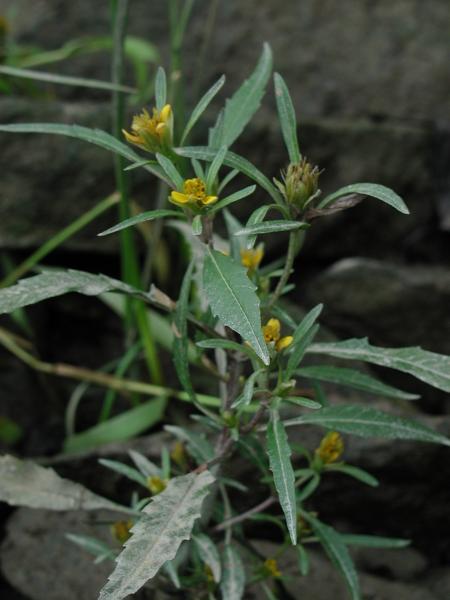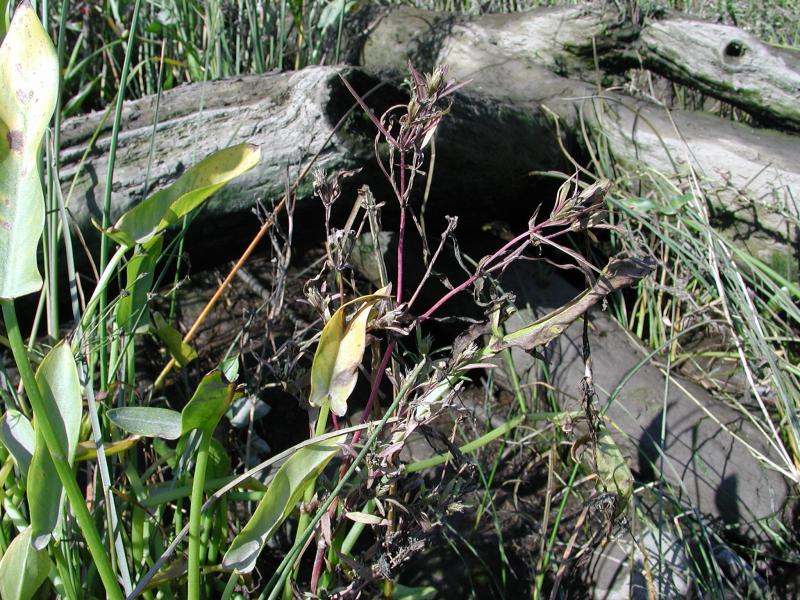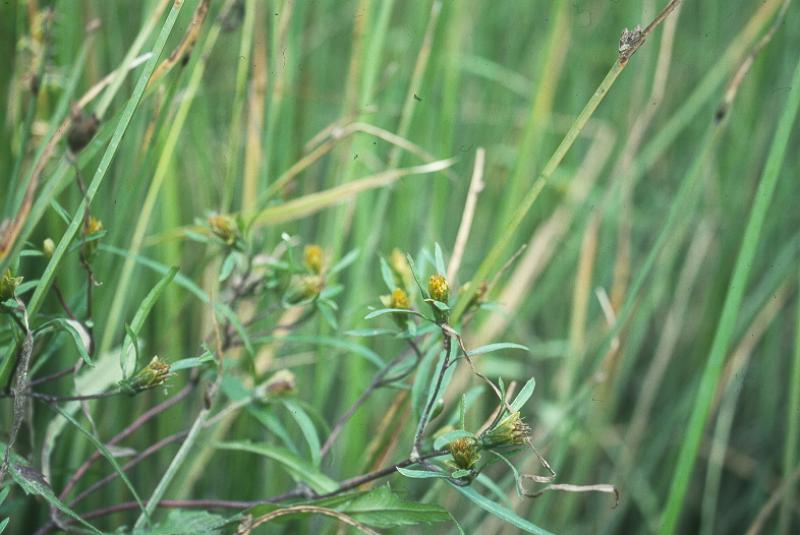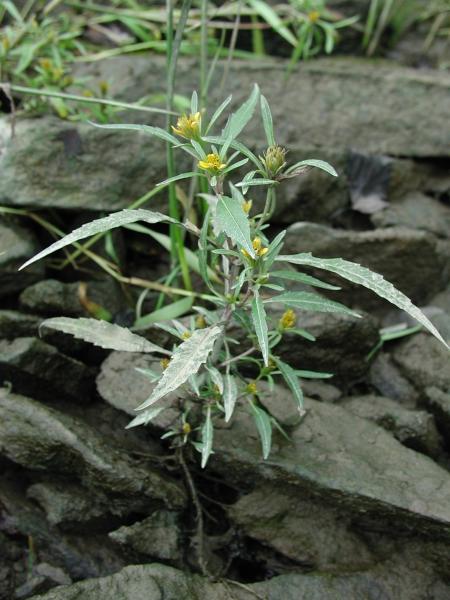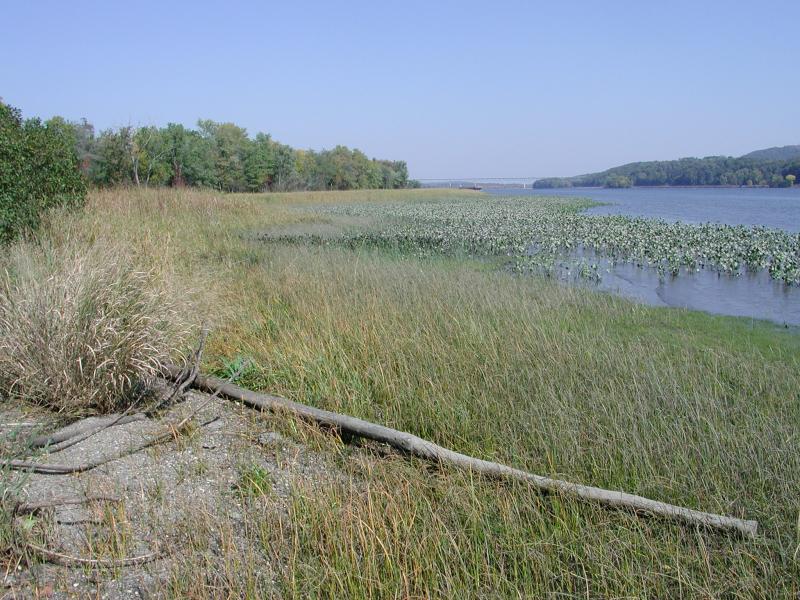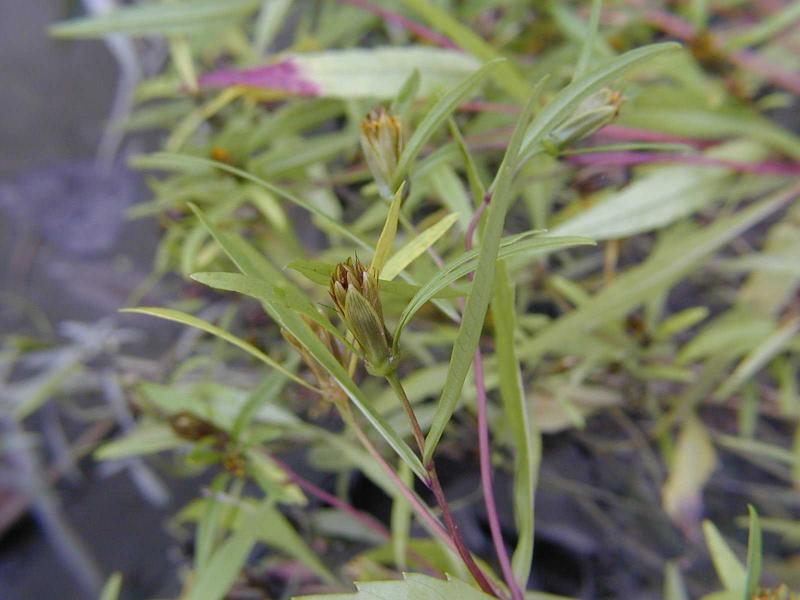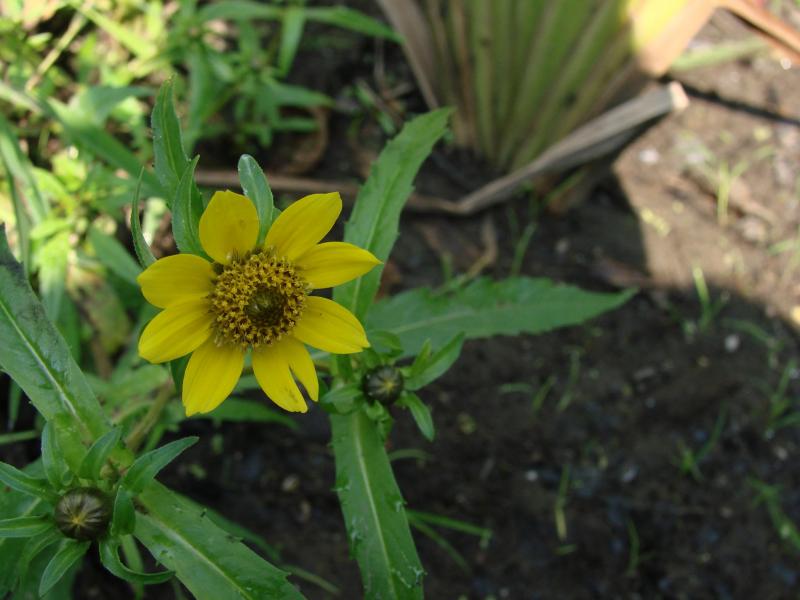Estuary Beggar Ticks
Bidens bidentoides (Nutt.) Britt.
- Class
- Dicotyledoneae (Dicots)
- Family
- Asteraceae (Aster Family)
- State Protection
- Rare
A plant listed as Rare by New York State. Removal or damage without the consent of the landowner is prohibited.
- Federal Protection
- Not Listed
- State Conservation Status Rank
- S3
Vulnerable in New York - Vulnerable to disappearing from New York due to rarity or other factors (but not currently imperiled); typically 21 to 80 populations or locations in New York, few individuals, restricted range, few remaining acres (or miles of stream), and/or recent and widespread declines.
- Global Conservation Status Rank
- G3G4
Vulnerable globally, or Apparently Secure - At moderate risk of extinction, with relatively few populations or locations in the world, few individuals, and/or restricted range; or uncommon but not rare globally; may be rare in some parts of its range; possibly some cause for long-term concern due to declines or other factors. More information is needed to assign either G3 or G4.
Summary
Did you know?
This species was originally placed in the genus Coreopsis and given the species name bidentoides because it resembled plants in the genus Bidens. Estuary beggar-ticks is being discovered with more frequency along the Hudson River. Some populations contain thousands of plants spread along the shoreline of the river.
State Ranking Justification
There are 26 existing populations and a few more populations may be discovered with more survey of Hudson River shoreline. Most historical records have been relocated but a few remain undiscovered.
Short-term Trends
Populations seemed to be stable along the Hudson River with many discoveries found within the last 20-30 years. Small occurrences may be found in additional riverside habitat but large populations are not likely.
Long-term Trends
Most of the historical records have been found and continue to survive although a few historical records are in areas that have been developed industrially and have become extirpated. Populations probably have fluctuated greatly in the past, especially when there was more industry along the river, but populations have recovered as habitats have become more natural again.
Conservation and Management
Threats
The shoreline habitats where this plant grows are threatened by erosion from boat wakes, overuse by recreational boaters, direct development or hardening of the shoreline and possibly by sea level rise in the future. Phragmites and purple loosestrife may be a threat in some areas but the severity is low.
Conservation Strategies and Management Practices
Maintain marsh natural processes and prevent recreational boating from affecting populations by siting docks and landings away from populations.
Research Needs
Research could be done on how sea level rise could affect this and other riverside species in the future.
Habitat
Habitat
In New York Bidens bidentoides has been found in freshwater tidal mudflats and marshes, often at the border between mudflat and marsh, or along sandy or muddy openings within a marsh (New York Natural Heritage Program 2007). Fresh or brackish tidal shores (Fernald 1970). Estuaries (Gleason 1952).
Associated Ecological Communities
- Freshwater intertidal mudflats
(guide)
A sparsely vegetated community characterized by low rosette-leaved aquatics. This community occurs on exposed intertidal mudflats where the water is fresh (salinity less than 0.5 ppt). This community is best developed where mudflats are nearly level so that broad expanses are exposed at low tide. The plants are completely submerged in 0.9 to 1.2 m (3 to 4 ft) of water at high tide and they are usually coated with mud.
- Freshwater intertidal shore*
(guide)
A community of the intertidal gravelly or rocky shores of freshwater tidal rivers and creeks, sometimes occurring at the base of cliffs. The vegetation may be very sparse.
- Freshwater tidal creek*
(guide)
The aquatic community of a shallow, tidally flooded freshwater creek with submerged areas averaging less than 2 m (6 ft) deep at low tide.
- Freshwater tidal marsh
(guide)
A marsh community that occurs in shallow bays, shoals, and at the mouth of tributaries of large tidal river systems, where the water is usually fresh (salinity less than 0.5 ppt), and less than 2 m (6 ft) deep at high tide. Typically there are two zones in a freshwater tidal marsh: a low-elevation area dominated by short, broadleaf emergents bordering mudflats or open water, and a slightly higher-elevation area dominated by tall grass-like plants.
* probable association but not confirmed.
Associated Species
- Bidens cernua (nodding beggar-ticks)
- Bidens laevis (smooth beggar-ticks)
- Eleocharis ovata (ovate spike-rush)
- Leersia oryzoides (rice cut grass)
- Lythrum salicaria (purple loosestrife)
- Nuphar
- Peltandra virginica (green arrow-arum, tuckahoe)
- Pontederia cordata (pickerelweed)
- Schoenoplectus americanus (chair-maker's bulrush)
- Schoenoplectus tabernaemontani (soft-stemmed bulrush)
- Zizania aquatica
Range
New York State Distribution
In New York this species occurs only in the lower (freshwater, but tidally influenced) portion of the Hudson River, upstream as far as Rennselaer County.
Global Distribution
This species is known only from large rivers and freshwater estuaries in the Mid-Atlantic region of the US, from New York south through New Jersey, eastern Pennsylvania, Delaware, and Maryland.
Identification Comments
General Description
Delmarva Beggar-ticks is an annual, opposite-leaved herb of tidal shores and mudflats. It has coarsely-toothed leaves which narrow at the base into slender petioles. Its flower heads are entirely discoid (lacking petal-like ray flowers), about 5 to 15mm wide, and erect. The disk corolla is 4-lobed, and the fruit are achenes, visibly striate (lined) under magnification.
Best Life Stage for Proper Identification
This species is best identified when in fruit.
Similar Species
Bidens laevis and Bidens cernua have a mature disk that is wider than 1.5 cm, 5-lobed disc flower corollas, and fruiting heads that are often nodding. Bidens hyperborea, B. laevis and B. cernua all have sessile leaves and a 4-awned achene that is convex and cartilaginous at the top. Bidens cernua has a stem that is soft and usually hispid (B. bidentoides has glabrous stems).
Best Time to See
This species flowers from late August into October, and fruits from late September into mid October.
- Flowering
- Fruiting
The time of year you would expect to find Estuary Beggar Ticks flowering and fruiting in New York.
Estuary Beggar Ticks Images
Images of Similar Species
Taxonomy
Estuary Beggar Ticks
Bidens bidentoides (Nutt.) Britt.
- Kingdom Plantae
- Phylum Anthophyta
- Class Dicotyledoneae
(Dicots)
- Order Asterales
- Family Asteraceae (Aster Family)
- Order Asterales
- Class Dicotyledoneae
(Dicots)
- Phylum Anthophyta
Additional Common Names
- Delmarva Beggar-ticks
Synonyms
- Bidens eatonii Fern. [Misapplied to some New York reports.]
Additional Resources
Best Identification Reference
Gleason, Henry A. and A. Cronquist. 1991. Manual of Vascular Plants of Northeastern United States and Adjacent Canada. The New York Botanical Garden, Bronx, New York. 910 pp.
Other References
Clemants, Steven and Carol Gracie. 2006. Wildflowers in the Field and Forest. A Field Guide to the Northeastern United States. Oxford University Press, New York, NY. 445 pp.
Fernald, M.L. 1950. Gray's manual of botany. 8th edition. D. Van Nostrand, New York. 1632 pp.
Holmgren, Noel. 1998. The Illustrated Companion to Gleason and Cronquist's Manual. Illustrations of the Vascular Plants of Northeastern United States and Adjacent Canada. The New York Botanical Garden, Bronx, New York.
Mitchell, Richard S. and Charles J. Sheviak. 1981. Rare Plants of New York State. Bull No. 445. New York State Museum. Univ. of New York. State Ed. Department Albany, NY.
New York Natural Heritage Program. 2010. Biotics database. New York Natural Heritage Program. New York State Department of Environmental Conservation. Albany, NY.
New York Natural Heritage Program. 2024. New York Natural Heritage Program Databases. Albany, NY.
Reschke, Carol. 1990. Ecological communities of New York State. New York Natural Heritage Program, New York State Department of Environmental Conservation. Latham, NY. 96 pp. plus xi.
Weldy, T. and D. Werier. 2010. New York flora atlas. [S.M. Landry, K.N. Campbell, and L.D. Mabe (original application development), Florida Center for Community Design and Research http://www.fccdr.usf.edu/. University of South Florida http://www.usf.edu/]. New York Flora Association http://newyork.plantatlas.usf.edu/, Albany, New York
Weldy, Troy W. and David Werier. 2005. New York Flora Atlas. [S.M. Landry, K.N. Campbell, and L.D. Mabe (original application development), Florida Center for Community Design and Research. University of South Florida]. New York Flora Association, Albany, NY. Available on the web at (http://newyork.plantatlas.usf.edu/).
Links
About This Guide
Information for this guide was last updated on: January 18, 2008
Please cite this page as:
New York Natural Heritage Program. 2024.
Online Conservation Guide for
Bidens bidentoides.
Available from: https://guides.nynhp.org/delmarva-beggar-ticks/.
Accessed July 27, 2024.
